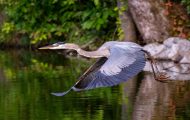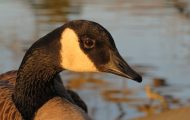Have you ever been minding your own business, and then suddenly, out of nowhere, you were attacked by a flock of angry birds? Well, it turns out that birds are more likely to attack humans than we may think; but why do birds attack people? Bird attacks occur for a variety of reasons.
Most of the time, they are reactions to disturbance or fear, while at other times, protection may be the driving factor. It’s important to understand why these attacks happen so that we can better avoid them in the future.
Let us explore the reasons why birds attack people and take measures to prevent it from happening again.
14 Bird Species That Attack Human
There are over 10,000 different kinds of birds in the world, and while most do not threaten humans, several species have been known to attack people. Some of these include:
① Ostriches
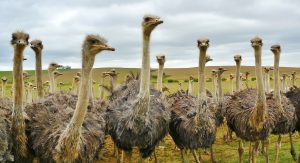
Ostriches are fascinating creatures. They’re the largest living bird species in the world, and they can live almost anywhere, from grasslands and savannas to deserts, making them incredibly adaptable. One of their most recognizable features is their long neck and powerful legs, which allow them to run faster than many animals on land. Their beautiful wings are made for running, not flying.
Surprisingly enough, despite looking so big and intimidating, ostriches have very poor eyesight and rely heavily on their acute senses of hearing and smell to sense danger and navigate the world around them. All that said, we do know that ostriches can be dangerous when provoked or protecting their nests – even humans can become unwitting targets!
Though it may be daunting to consider a full-grown ostrich as an aggressive predator, rest assured that potential attack behaviors should never go unsocialized when it comes to handling these amazing creatures.
② Cassowary
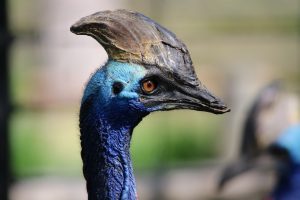
The Cassowary is a species of large flightless bird that is native to Australia, New Guinea, and nearby islands. They have powerful hooked beaks, solid black plumage, and tall, scaly casques on their heads.
This remarkable species possesses some of the longest legs in the avian world and can measure up to 2 meters from bill to tail-tip! While these birds look intimidating – with those razor-sharp claws – they generally avoid contact with humans and are actually quite shy.
Cassowaries are mostly active during dusk and dawn, foraging for fruits, insects, and frogs in their natural forest habitat. It’s a bird truly unlike any other you may come across, but if threatened can show aggressive behavior. Therefore, it’s best to observe them from a safe distance.
③ Owls

These unique birds of prey are distinct through their incredible size and diverse range. Even more so, they possess a marked intelligence, enabled by large brains relative to their body size, that helps owls survive in the wild. Their impressive ability to fly noiselessly provides them with the distinct advantage of being able to sneak up on unsuspecting prey without alerting it, resulting in a successful hunt more times than not.
Taking it further, studies indicate that owls can also distinguish different colors and remember certain hunting spots, adding to their intrigue and mysteriousness as predators. One thing is sure when we humans come face-to-face with an owl. We might be faced with something unexpected!
④ Gulls

Gulls are some of the most recognizable birds out there. Their white, gray, and black feathers make them easy to identify from a distance, and they can be found near almost any body of water. In fact, these creatures often come in quite large flocks, making their presence that much more noticeable!
In terms of size, Gulls generally measure about two feet in length with a wingspan between three and five feet. They mainly feed on marine life no matter where they are located, close to an ocean or inland near a lake or river. These birds also have an above-average vision and an impressive flying speed reaching up to 80 km/h when diving after prey or continually moving to search for food sources.
Altogether, gulls are a fantastic bird species with plenty of fascinating features – but they aren’t exactly known for being human-friendly creatures!
⑤ Canadian Goose
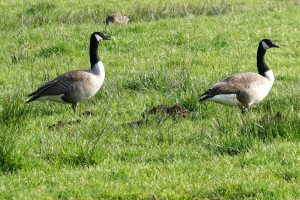
Canadian Geese have earned quite a reputation for themselves – and not in the best way! These beautiful birds are actually quite aggressive toward humans. The thing is, if approached, they can get quite defensive, flapping their wings or even attacking if threatened enough. They grow to be around two feet long with a wingspan of four feet or more, making them pretty intimidating up close.
Despite their aggression issues, they’re quite popular with bird watchers. The loud honking calling and V-shape flying formations make them a sight to behold in the wild. And those distinctive black head and neck combined with white cheeks are certainly an impressive look.
⑥ American Crow

When it comes to bird species that attack humans, crows are certainly one of the most well-known. Found all around the world, these clever birds have a naughty streak and can often be seen stealing food from unsuspecting people or ruining picnics with their scavenging habits.
Crows are easily recognizable due to their distinctive black feathers and sharp eyesight, as well as their loud calls and intimidating nature. Although they look small and harmless, crows have been known to fiercely defend their territory if they perceive there is an immediate threat.
They have also been observed gathering among themselves to scare away potential predators, an incredible feat given their tiny size compared to larger animals like raptors or cats.
⑦ Magpie
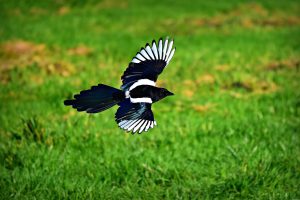
Magpies are beautiful birds, often boasting bright blue or purplish feathers and black accents. They tend to live in flocks and can be found in treetops or occasionally on the ground. Though these birds may appear inviting with their distinctive features, they have been known to attack unsuspecting humans from time to time.
Magpies are also considered omnivores, sharing much of their diet of fruit, nuts, insects, and small animals with other species—including humans! While it’s not exactly clear why magpies sometimes attack humans, those who have suffered such an encounter fear them deeply. It’s best to give these unique animals a respectful distance if possible.
⑧ Swallows
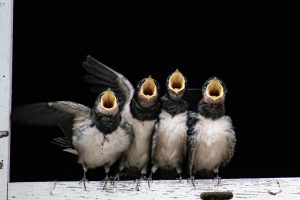
Swallows are pretty interesting creatures. They have a slim and slender body shape, a pointed tail, a streamlined aerodynamic shape, and short legs, allowing them to be incredibly agile in the air. These birds are most known for their acrobatic flight patterns and ability to soar effortlessly through the sky. They come in different colors ranging from pale blue-gray to violet-blue and chestnut brown to black.
Swallows feed on small insects plucked from the air during their flight. Their diet includes gnats, flies, mosquitoes, beetles, and dragonflies. All these features help swallows find food easily and efficiently when hunting.
Despite seeming harmless little birds, swallows can become hostile and act aggressively toward humans if they feel threatened or disturbed. That being said, they can still make an interesting site in your yard or garden!
⑨ Mockingbirds
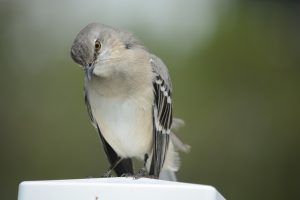
Mockingbirds, members of the Mimidae family, are birds often recognized by their melodic songs. They come in different species and sizes and can be found in various locations, such as tropical mountain forests, subtropical roofs, and more. Although they are generally secretive creatures and spend most of their time quietly in trees or bushes, mockingbirds have been known to attack humans for no obvious reason.
Their aggression is strange because they usually form a safe bond between themselves and humans – defending their territory from predators. Mockingbird’s feathers appear gray from afar but take on an iridescent splash of colors on closer inspection. The many shades of blue really stand out against their clean white underbellies.
⑩ American Robin
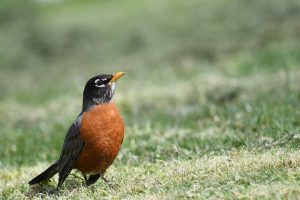
The American Robin is one of North America‘s most recognizable birds. With its bright red chest and black head, this bird species can be spotted year-round throughout most of the country. An omnivore, they feast on bugs and berries, depending on the current season.
In addition to singing a pleasant song and being an all-around delight to watch in your garden or backyard, these birds are also quite brave with their own territorial instincts. They rarely shirk away from having run-ins with other pesky creatures or animals that want to occupy their space.
Despite this, however, it’s worth noting that there’s no valid reason for them to intentionally attack humans unless provoked—which is rarely the case. Of course, if you get too close to the nest or robin eggs, then the mother might swoop down. But even then, it tends not to be aggressive behavior.
⑪ Lammergeier
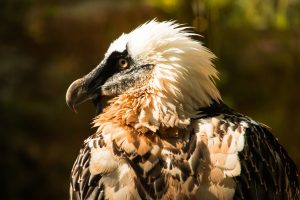
The Lammergeier is an accomplished predator, despite its humble size and stature. Residing mainly in the high hills of Southern Europe and Central Asia, these majestic creatures possess wingspans up to 8 feet wide, allowing them to glide effortlessly between mountainous perches. They have a unique diet of lizards, tortoises, birds, and mammals, although they will sometimes resort to scavenging carrion.
According to studies made on Lammergeiers, they show remarkable intelligence in seeking out food sources and cleverly adjusting their foraging habits according to seasonal variation. Although there have been occasional cases of Lammergeiers attacking humans or their livestock, the majority are very shy and reclusive creatures who avoid conflict with people whenever possible.
⑫ Blue Jay
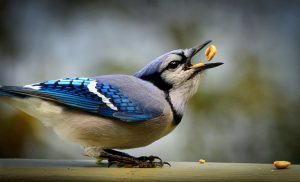
The Blue Jay is a large, industrious songbird found in many backyards throughout North America. They have beautiful blue feathers and an ash-gray back with black-barred wings and tails for camouflage in trees. Blue Jays are smart and adaptable creatures. They make various sounds, from claws to whistles, can live both off the land or scavenge food from humans, and take advantage of any resources they come across.
They’re even capable of problem-solving – some jays have learned to store nuts and crack them later using tools like rocks. Not only are they interesting birds to observe, but it’s also believed that their presence helps other birds avoid predators by acting as lookouts for danger.
⑬ Hawks
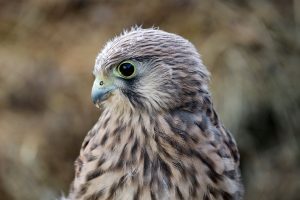
Hawks are often incredibly majestic-looking raptors with fierce and serious looks in their eyes. Their feathers are usually a variety of colors, ranging from browns, grays, and white, to blues and red. Depending on the species of hawks, some have unusual facial patterns or colorful patches on their breasts that set them apart. Hawks bolt through the sky with superior agility while they hunt for prey. During mating season, they will dash around, intent to attract a mate or fend off another Hawk who poses a threat to their partner. Hawks have strong talons; it’s no wonder why they can sometimes attack humans, unsuspecting of their presence.
⑭ Red Winged Blackbird

These birds have distinctive black feathers and bright red and yellow shoulders—it’s quite a striking combination. They are quite bold creatures, too, and won’t shy away from humans who come close to them in their territory.
With a slightly intimidating call, they let anyone know their presence while they soar around searching for seeds or invertebrates to feast on. Despite their unique beauty, it is best to admire these birds from a distance!
Why Do Birds Attack People: The Reasons Behind It
When it comes to birds attacking humans, there are a few potential reasons why. Here are a few of the most common:
🦅 Instinct and Territorial Behavior
It makes sense why birds would attack people to protect their territory – it’s in their instincts, after all. When a bird views a person as a threat, it will be much more likely to act on it than if it were another bird. This is because birds will instinctively protect their space. Thus, intruders can be seen as an imminent danger needing removal from the area.
The behavior doesn’t just apply to members of other species, though. Play fights between birds within the same flock are also common and can often result in aggressive pecking or chasing after one another.
Therefore, if a human invades the bird’s domain and perturbs them in some way, it’s not entirely surprising for them to retaliate in an aggressively defensive manner.
🦅 Provocation and Fear
Most of the time, birds only attack people because they’re feeling provoked or scared. If a bird’s nest or young is nearby, the parents may act aggressively towards anyone who gets close out of fear that their chicks will be in danger. Similarly, animals can become agitated if humans threaten or disturb their habitat. In these cases, birds may resort to defensive tactics such as dive-bombing or swooping at intruders to protect themselves and their young from perceived threats.
That being said, if you are actively trying to chase away a certain bird species without knowing how to do so safely and properly, this could increase your chances of provoking attacks!
🦅 Misinterpretation of Human Behavior
Birds often attack humans out of a misinterpretation of our behavior. This is particularly true for wild birds that are trained not to trust people due to their poor experiences in the past. They perceive actions such as reaching out to them as potentially threatening and therefore attack first without understanding the likely harm-free nature of our advances toward them.
Even seemingly innocuous activities, such as walking near bird nests, can be misinterpreted by a protective parent bird, leading them to become aggressive towards us. As such, it’s incredibly important that when we are around wildlife, we remain conscious of how our presence may be misinterpreted and potentially lead to conflict between us and the animal kingdom.
🦅 Food Competition
Generally, if a bird views people as a food source, it may become aggressive and launch an attack. In some cases, such as with nesting seagulls or crows in urban areas, birds will see humans as competitors for food and react accordingly with aggression.
Additionally, certain species of birds may view humans as predators and treat us like they would any other potential threat – by attacking preemptively. Ultimately, the behavior is simply an attempt to protect themselves or their nests.
🦅 Human Impact on Bird Habitats
It’s no secret that human activity is having a huge impact on the habitats of many birds. We’re encroaching on their nesting spots, destroying the natural vegetation they rely on, and introducing new species or pollutants into their environment. In some cases, these changes cause birds to become displaced and desperate for food, forcing them to take the opportunity of resources closer to humans instead.
These encounters with people can frighten the birds, leading them to act defensively by attacking. Even more concerningly, if the bird is accustomed to humans, then it may associate them with providing food and attack in search of a handout. Unfortunately, this means that any human entering the bird’s habitat could be subject to an attack due to our activities.
🦅 Migration Season
Migration season can cause birds to act a bit strangely. Since they often fly further distances and may feel stressed or tired after their long flights, they become easily agitated if they feel threatened and can show this hostility by attacking humans.
In addition, bird populations grow in certain areas because of migration season. Plus, food sources become scarcer, and birds try to defend their territory from intruders—even humans. We need to remember that when we enter an area with birds, we do not want to disrupt the normal patterns of their behavior.
Lastly, migratory birds may mistake people’s heads, hands, or facial features for other large animals like cats or owls, which they would consider predators. This mistaken identity could lead them to act aggressively toward humans to protect themselves and their eggs.
What To Do If You Are Attacked
So, what should you do if you find yourself in the middle of a bird attack? Here are a few tips that could help:
✅ Stay calm, and Don’t Panic
Being attacked by birds can be a frightening experience, so it is important to stay calm and not panic. Taking deep breaths and counting slowly to ten can help you to keep a level head. It may seem like your first instinct would be to run or fight back, but this will often only worsen the situation.
If you find yourself in an area where birds are nesting during the spring or summer months, be careful and try avoiding them if possible. Instead of fleeing or bringing attention to yourself, moving calmly away from the area and toward safety is best. Always remember that you are safest if you remain as calm as possible. Do not do anything that could further agitate the birds.
✅ Protect Your Head and Face
If the birds continue attacking, protect your face with your forearms. Use an article of clothing or whatever you can find to cover the back of your head and neck. It’s also helpful to stay low if possible so birds have a harder time targeting the head.
✅ Seek Shelter
It’s important to seek shelter as quickly as possible. Depending on the size of the bird and any weapons they might have, the last thing you want is a physical fight! Try and get inside a building if you can. Otherwise, take cover in some way that protects you from their pecking or swipes.
Once sheltered, it’s important to keep calm and observe the birds’ behavior. Remain respectful and don’t provoke them. Therefore, you can consider your options when they decide to move on. It also helps to note their location so that you know where not to go once the attack has ceased.
✅ Avoid The Area Altogether
To ensure your safety in such a situation, it is a good idea to avoid areas where there are large congregations of birds. This may mean changing your regular travel route or planning ahead when venturing outdoors. In addition to staying away from these places, it’s also a good idea not to antagonize any birds during your time outside.
Doing so may set off an attack and put your well-being at risk. Furthermore, if you cannot leave the area right away for whatever reason, then make sure that you remain alert and keep as much distance as possible between yourself and the birds. Never try to confront them directly, as this will only stir up more trouble!
Frequently Asked Questions
Q: Are large bird species more likely to attack humans than smaller ones?
A: Generally speaking, larger bird species, such as hawks and owls, are more likely to attack humans than smaller birds, like sparrows, finches, and hummingbirds. This is because larger bird species have more powerful wings and talons that they can use to defend themselves and their nests. It is also important to note that many birds may attack if they feel threatened, regardless of size.
Q: What does a crow attack look like?
A: A crow attack can involve multiple birds, usually approaching their target rapidly and aggressively, flapping their wings, and cawing loudly. They may also dive-bomb their target, pecking and clawing at them with their strong talons. In some cases, a crow attack can also include other birds joining in the fray. It is important to remain calm and move away from the area quickly and safely.
Q: When it’s nesting season, are birds more aggressive?
A: During the nesting season, birds can become very defensive and territorial. As a result, they may swoop down and attack any perceived threats to their young. It is important to remain aware of your surroundings when outdoors in the nesting season and to respect birds’ nests. If you see a bird’s nest, then it is best to keep your distance and not disturb them.
Q: How to prevent birds from attacking me?
A: The best way to prevent bird attacks is to remain aware of your environment. Keep a respectful distance from any birds and their nests. It is also important to avoid making sudden movements or loud noises around birds. This may provoke them into defending themselves. Furthermore, it is a good idea to avoid areas with large bird congregations. Finally, if you find yourself amid a bird attack, seek shelter as quickly as possible and do not antagonize the birds in any way.
Q: Can birds transmit any diseases to humans?
A: While it is rare, some birds can transmit diseases such as salmonella and E. coli to humans. It is best to take extra precautions when handling any birds or their droppings. These can contain bacteria and other harmful substances. It is also important to thoroughly wash your hands after handling birds or coming into contact with their droppings.
Final Words
Bird attacks can be a frightening and potentially dangerous experience. However, you can stay safe with the right knowledge and precautionary measures. Remember to remain aware of your surroundings. Avoid areas with large congregations of birds. Plus, if you find yourself in a situation with a risk of attack, make sure to remain calm and move away from the area as quickly and safely as possible. With these tips in mind, you can ensure that your time outside is enjoyable and free of any unwanted encounters.

